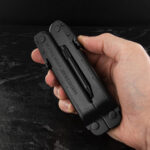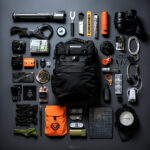How to Assess Your Surroundings Like an FBI Agent
The tradecraft guide on situational awareness, modeled after techniques employed by FBI agents and tailored for covert operatives as well as civilians.
It covers the OODA Loop (Observe, Orient, Decide, Act) as a foundational decision-making framework and introduces specialized tools and exercises like Kim’s Game and the Color Codes of Awareness to sharpen perception and readiness.
Additionally, it outlines practical guidelines and best practices to maintain an elevated state of alertness in diverse environments. Designed as a comprehensive manual, this intel aims to equip individuals with the skills needed to assess risks effectively and respond to potential threats in a timely and informed manner.
Situation awareness is not merely a skill set; it’s a mindset. As someone operating in covert intelligence, you already know that one wrong step can compromise an entire operation. While these skills are invaluable in the high-stakes world of intelligence operations, they are also remarkably applicable to day-to-day civilian life. Enhanced situational awareness can increase your personal safety in public spaces, protect your assets, and safeguard your well-being.
In this guide, we cover the concept of situation awareness, dissect the tradecraft techniques commonly used by agents of the Federal Bureau of Investigation (FBI), and offer guidelines for implementing these practices in your daily life.
The OODA Loop: Observe, Orient, Decide, Act
The OODA Loop, initially conceptualized by military strategist John Boyd, is a decision-making process routinely employed by FBI agents and covert operatives alike. Here’s how you can incorporate it into your routine:
Observe
Visual Scanning: Use a zig-zag scanning method, moving your eyes horizontally then vertically through an area, to quickly and efficiently observe your surroundings.
Auditory Clues: Listen for atypical sounds or tones of voice. They can be as telling as visual cues.
Smell and Sensation: Sometimes odors or temperature changes can indicate impending danger.
Orient
Baseline Behavior: Identify what’s “normal” in your environment, then look for anomalies.
Sensory Input: Integrate information from all senses to get a full understanding.
Local Customs and Culture: Being aware of local norms can help you blend in and better recognize deviations from the norm.
Decide
Threat Assessment: Evaluate the potential risks and their immediacy.
Prioritization: Decide which risk factors need to be addressed first.
Act
Immediate Action: If an immediate threat is identified, the operative’s training should kick in to neutralize the threat effectively.
Information Forwarding: For less immediate threats, perhaps consider forwarding the information to local law enforcement or security forces.
Techniques and Tools
Kim’s Game
A classic intelligence exercise, Kim’s Game, trains operatives to quickly and accurately remember details about their surroundings. This exercise can be adapted and practiced in everyday scenarios. Take mental snapshots of your environment and review them later. This sharpens your attention to detail and helps you notice when something changes.
Kim’s Game is a time-tested exercise designed to enhance your observational and memory skills, aspects critical for situational awareness and effective tradecraft. While originally a game for children, its application has evolved over the years and is now a fundamental part of training for intelligence officers, special forces, and law enforcement agencies.
Preparations
Select Objects: Choose a variety of small objects, preferably between 10 and 20 – and place them on a tray or table. The objects should be diverse in nature: a pen, a coin, a key, etc.
Location and Environment: Choose a quiet, distraction-free environment. Your focus should be solely on the game.
Participants: This can be a solitary exercise or performed with a group, where each participant takes turns in both roles of observer and tester.
Initial Observation Phase
Time Frame: Allow yourself or the participants approximately one minute (adjust time as necessary based on skill level) to observe and memorize the objects on the tray.
Mental Snapshot: As you observe the items, take a “mental snapshot” of the scene. Pay attention to the arrangement of objects, their colors, and any distinguishing features.
Concealment Phase
- Cover the Objects: After the observation time has expired, cover the objects with a cloth or remove them from the field of view.
- Memory Recall: Use this time to mentally recap the items you observed. Try to visualize them, imagine their textures, and remember their spatial arrangement.
Test Phase
- List the Objects: Write down as many objects as you can remember. If you’re working with a partner, this is the time to compare notes.
- Check for Accuracy: Uncover the objects and compare them with your list. Note what you missed and what you got correct.
- Detail Recall: For advanced practitioners, add layers of complexity by also recalling specific details about each object. For example, what was the brand of the pen? Was the coin heads up or tails up?
Review and Adapt
- Self-Assessment: Evaluate your performance. Were there certain types of objects that you found easier or harder to remember?
- Iterative Learning: The more you practice Kim’s Game, the better you’ll get. Vary the objects and conditions to keep the exercise challenging.
By making Kim’s Game a regular part of your training regimen, you’ll find that your capacity for situational awareness — key to the tradecraft of any operative — will greatly improve. The exercise will train your mind to quickly capture details that might escape others, a skill invaluable both in the field and in daily life.
Color Codes of Awareness
White: Unaware and unprepared. Being in this state in a public setting could leave you vulnerable.
Yellow: Relaxed but alert. Ideal for most public spaces.
Orange: Specific alert. Something is not right, and you’ve moved your focus toward it.Red: Fight or flight. Immediate threat identified and action needed.
Elicitation Techniques
In certain scenarios, subtle elicitation techniques can be used to gather information from individuals without raising suspicion. Techniques like assumption and flattery can often yield more information than direct questioning.
Best Practices for Everyday Civilians
Regularly Update Your Mental Map: When entering a new area, identify escape routes, potential threats, and safe zones.
360-Degree Check: Periodically perform a full circle check to assess your surroundings from all angles.
Maintain an Exit Strategy: Always know how you’ll get out of a situation before you get into it.
Situation awareness is an indispensable skill set for covert operatives, FBI agents, and everyday civilians alike. By taking a few pages out of the FBI’s playbook and integrating them into your life, you can significantly improve your ability to recognize, assess, and react to potential threats. The world may be unpredictable, but your preparations don’t have to be.
Like any good operative, be ever-vigilant, hone your tradecraft, and adapt as the landscape changes. With situational awareness at your disposal, you are always one step ahead.
[INTEL: Profiling People Like The FBI]







